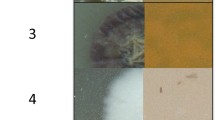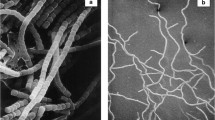Abstract
Streptomyces strain LL-P018 produces the phaeochromycins, novel anti-inflammatory polyketides. This organism was identified as a strain of Streptomyces phaeochromogenes by physiological and genetic taxonomic analysis. In order to gain greater taxonomic perspective, LL-P018 was compared to related strains from major culture collections by 16S rRNA gene sequence, ribotype, HPLC–MS metabolite profile, and rpoB sequence. Using BioNumerics software, genetic and chemical fingerprint data were integrated via multivariate cluster analysis into a single, robust comparison. Based upon this analysis, strain LL-P018 is very closely related to the type strains of both S. phaeochromogenes and Streptomyces ederensis, indicating that these two types may in fact represent a single species. This novel comparative multi-cluster analysis is most useful for clarifying relationships between closely related species.








Similar content being viewed by others
References
Altschul SF et al (1997) Gapped BLAST and PSI-BLAST: a new generation of protein database search programs. Nucleic Acids Res 25(17):3389–3402
Anderson AS, Wellington EMH (2001) The taxonomy of Streptomyces and related genera. Int J Syst Evol Microbiol 51(3): 797–814
Anzai Y, Okuda T, Watanabe J (1997) Application of the random amplified polymorphic DNA using the polymerase chain reaction for efficient elimination of duplicate strains in microbial screening. II. Actinomycetes. J Antibiot 50(4):C-1
Baltz RH (1997) Lipopeptide antibiotics produced by Streptomyces roseosporus and Streptomyces fradiae. In: Strohl WR (ed) Drugs and the pharmaceutical sciences. Marcel Dekker, New York, pp 415–435
Baltz RH (2006) Marcel faber roundtable: is our antibiotic pipeline unproductive because of starvation, constipation or lack of inspiration? J Ind Microbiol Biotechnol 33(7):507–513
Beijerinck MW (1900) Ueber Chinonbildung durch Streptothrix chromogena und Lebensweise dieses Mikroben. Centr Bakteriol Parasitenk Abt II 6:2–12. Cited In: Waksman and Curtis (1916) and Waksman (1959)
Bruce J (1996) Automated system rapidly identifies and characterizes microorganisms in food. Food Technol 50:77–81
Challis GL, Hopwood DA (2003) Synergy and contingency as driving forces for the evolution of multiple secondary metabolite production by Streptomyces species. Proc Natl Acad Sci USA 100(suppl 2):14555–14561
Chater KF, Bibb MJ (1997) Regulation of bacterial antibiotic production. In: Kleinkauf H, Von Doehren H (eds) Biotechnology, 2nd edn. Wiley, Weinheim, pp 57–105
Clardy J, Fischbach MA, Walsh CT (2006) New antibiotics from bacterial natural products. Nat Biotechnol 24(12):1541–1550
Conn HJ (1917) Soil flora studies. V. Actinomycetes in soil. NY Agr Exp Sta Tech Bull 60:1–16
Graziani EI et al (2005) Phaeochromycins A–E, anti-inflammatory polyketides isolated from the soil actinomycete Streptomyces phaeochromogenes LL-P018. J Nat Prod 68(8):1262–1265
Hansen JN (1997) Nisin and related antimicrobial peptides. In: Strohl WR (ed) Drugs and the pharmaceutical sciences. Marcel Dekker, New York, pp 437–470
Jack R, Gotz F, Jung G (1997) Lantibiotics. In: Kleinkauf H, Von Doehren H (eds) Biotechnology, 2nd edn. Wiley, Weinheim, pp 323–368
Jukes TH, Cantor CR (1969) Evolution of protein molecules. In: Munro HH (ed) Mammalian protein metabolism. Academic Press, New York, pp 21–132
Kim BJ et al (2004) Phylogenetic analysis of the genera Streptomyces and Kitasatospora based on partial RNA polymerase beta-subunit gene (rpoB) sequences. Int J Syst Evol Microbiol 54(Pt 2):593–598
Kotlyarov A et al (1999) MAPKAP kinase 2 is essential for LPS-induced TNF-alpha biosynthesis. Nat Cell Biol 1(2):94–97
Lanoot B et al (2005) Grouping of streptomycetes using 16S-ITS RFLP fingerprinting. Res Microbiol 156(5–6):755–762
Mankelow DP, Neilan BA (2000) Non-ribosomal peptide antibiotics. Exp Oper Therap Pat 10(10):1583–1591
Nicas TI, Cooper RDG (1997) Vancomycin and other glycopeptides. In: Strohl WR (ed) Drugs and the pharmaceutical sciences. Marcel Dekker, New York, pp 363–392
Pearson K (1926) On the coefficient of racial likeness. Biometrika 18:105–1171
Pfaller MA et al (1996) Comparative evaluation of an automated ribotyping system versus pulsed-field gel electrophoresis for epidemiological typing of clinical isolates of Escherichia coli and Pseudomonas aeruginosa from patients with recurrent gram-negative bacteremia. Diagn Microbiol Infect Dis 25(1):1–8
Piepersberg W, Distler J (1997) Aminoglycosides and sugar components in other secondary metabolites. In: Kleinkauf H, Von Doehren H (eds) Biotechnology, 2nd edn. Wiley, Weinheim, pp 397–488
Reysenbach AL, Wickham GS, Pace NR (1994) Phylogenetic analysis of the hyperthermophilic pink filament community in Octopus Spring, Yellowstone National Park. Appl Environ Microbiol 60(6):2113–2119
Ritacco FV et al (2003) Dereplication of Streptomyces soil isolates and detection of specific biosynthetic genes using an automated ribotyping instrument. J Ind Microbiol Biotechnol 30(8):472–479
Rullmann W (1895) Chemisch-bakteriologische Untersuchungen von Zwischendeckenfüllungen, mit besonderer Berücksichtigung von Cladothrix odorifera. Universität München. Cited in Waksman and Curtis (1916) and Waksman (1959): Munich, Germany
Schatz A, Bugie E, Waksman SA (1944) Streptomycin, a substance exhibiting antibiotic activity against gram-positive and gram-negative bacteria. Proc Soc Exp Biol Med 55:66–69
Sehgal SN, Baker H, Vezina C (1975) Rapamycin (AY–22,989), a new antifungal antibiotic. II. Fermentation, isolation and characterization. J Antibiot (Tokyo) 28(10):727–732
Shirling EB, Gottlieb D (1966) Methods for characterization of Streptomyces species. Int J Syst Bacteriol 16(3):313–340
Strohl WR (1997) Industrial antibiotics: today and the future. In: Strohl WR (ed) Drugs and the pharmaceutical sciences. Marcel Dekker, New York, 1–47
Thompson JD et al (1997) The CLUSTAL_X windows interface: flexible strategies for multiple sequence alignment aided by quality analysis tools. Nucleic Acids Res 25(24):4876–4882
Ueda K et al (1999) Two distinct mechanisms cause heterogeneity of 16S rRNA. J Bacteriol 181(1):78–82
Van de Peer Y, De Wachter R (1994) TREECON for Windows: a software package for the construction and drawing of evolutionary trees for the Microsoft Windows environment. Comput Appl Biosci 10(5):569–570
Vauterin L, Vauterin P (2006) Integrated databasing and analysis. In: Stackebrandt E (ed) Molecular identification, systematics, and population structure of prokaryotes. Springer, Heidelberg, 141–217
Waksman SA (1959) The actinomycetes, vol 1. Nature, occurrence, and activities, vol 1. Wilkins, Baltimore
Waksman SA, Curtis RE (1916) The actinomyces of the soil. Soil Sci 1:99–134
Waksman SA, Woodruff HB (1942) Streptothricin, a new selective bacteriostatic and bactericidal agent, particularly active against gram-negative bacteria. Proc Soc Exp Biol Med 49:207–210
Walsh CT (2003) Antibiotics: actions, origins, resistance. Washington DC, ASM Press
Walsh CT (2004) Polyketide and nonribosomal peptide antibiotics: modularity and versatility. Science 303(5665):1805–1810
Wink J (2002) The Actinomycetales: an order in the class of Actinobacteria important to the pharmaceutical industry- electronic manual. CD-Rom Provided by Dr, Joachim Wink, Aventis Pharma Deutschland GmbH
Acknowledgments
The authors would like to acknowledge Kyle Kingsley (Applied Maths, Austin, TX, USA) and David Labeda (United States Department of Agriculture, Peoria, IL, USA) for assistance with taxonomic experiments, Jan Kieleczawa for DNA sequencing, and Leonard McDonald for chemistry advice and assistance.
Author information
Authors and Affiliations
Corresponding author
Rights and permissions
About this article
Cite this article
Ritacco, F.V., Eveleigh, D.E. Molecular and phenotypic comparison of phaeochromycin-producing strains of Streptomyces phaeochromogenes and Streptomyces ederensis . J Ind Microbiol Biotechnol 35, 931–945 (2008). https://doi.org/10.1007/s10295-008-0367-0
Received:
Accepted:
Published:
Issue Date:
DOI: https://doi.org/10.1007/s10295-008-0367-0




